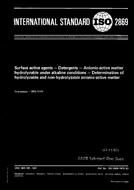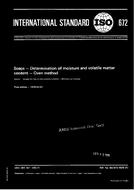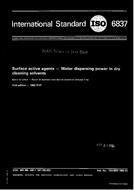We need your consent to use the individual data so that you can see information about your interests, among other things. Click "OK" to give your consent.

ISO 2869:1973
Surface active agents — Detergents — Anionic-active matter hydrolyzable under alkaline conditions — Determination of hydrolyzable and non-hydrolyzable anionic-active matter
Automatically translated name:
Surface active agents -- Detergents -- Anionic-active matter hydrolyzable under alkaline conditions -- Determination of hydrolyzable and non-hydrolyzable anionic-active matter
STANDARD published on 1.12.1973
The information about the standard:
Designation standards: ISO 2869:1973
Publication date standards: 1.12.1973
SKU: NS-430555
The number of pages: 2
Approximate weight : 6 g (0.01 lbs)
Country: International technical standard
Category: Technical standards ISO
The category - similar standards:
Annotation of standard text ISO 2869:1973 :
Description / Abstract: The determination is carried out as follows: Titration of an aliquiot portion of a sample solution with benzethonium chloride solution according to the direct two-phase titration procedure describes in ISO 2271. Hydrolysis by refluxing under alkaline conditions of a second aliquot portion of the sample solution. Titration of unhydrolyzed anionic-active matter with benzethonium chloride solution as before. Calculation of the contents of hydrolyzable and non-hydrolyzable anionic-active matter from the results obtained.
Similar standards:
9.11.1989
1.2.1978
1.6.1981
1.4.1981
1.2.1983
1.12.1982
We recommend:
Updating of laws
Do you want to be sure about the validity of used regulations?
We offer you a solution so that you could use valid and updated legislative regulations.
Would you like to get more information? Look at this page.


 ISO 6388:1989-ed.2.0..
ISO 6388:1989-ed.2.0.. ISO 672:1978
ISO 672:1978 ISO 673:1981-ed.2.0..
ISO 673:1981-ed.2.0.. ISO 6835:1981
ISO 6835:1981 ISO 6836:1983
ISO 6836:1983 ISO 6837:1982
ISO 6837:1982
 Cookies
Cookies
